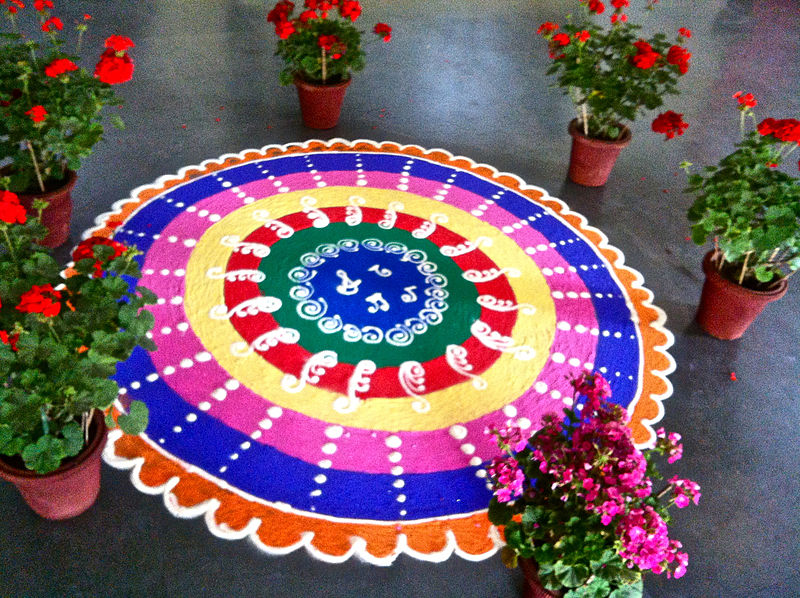Activity
Making Rangoli: A Celebration of Color
Objective: Students will: 1.) examine the Hindu tradition of threshold art; 2.) discuss how Indian values are expressed in the ephemeral art of threshold painting; 3.) draw traditional connect-the-dots threshold art designs; 4.) make colored rice flour and create an auspicious floor painting

Materials:
Rice flour (denser than wheat flour; sold at Indian food markets), food dye, zip lock bags, cups, large sheets of brown butcher paper, water; Map of India (see above); Artworks: photos of Indian threshold floor and wall paintings (see suggested resources below); Worksheets: Threshold Art: Connect the Dot Designs and Template of Dots: Four Points Forming a Rhomboid; Video: Rangoli
Overview:
Throughout the subcontinent of India, women of all ages, castes, and professions, perform the traditional art of threshold painting. It is known as muggu in Andhra Pradesh; rangoli in Maharashtra and Gujarat; chowk purana in Uttar Pradesh; mandana in Rajasthan; alpana in Bengal; chita in Orissa; and kolam in Tamil Nadu. Although the styles of design and frequency with which it is painted vary from region to region, the symbolic meaning of this art form is the same: it links Hindu women to the goddess Lakshmi whom they invite to depart her heavenly abode and rest momentarily at their thresholds upon an intricate rice flour diagram. In this manner, the Goddess brings good fortune, enveloping the home in an auspicious sphere of protection.
In a variety of ways, threshold art reflects the Hindu concept of the interconnectedness of the universe. This is symbolized even in the use of rice flour as an artistic medium. It is said that the kolam is the “feeder of a thousand souls” providing nourishment to the smallest of insects throughout the day. Also central to Hinduism is the experiential act of devotion. The painting of a kolam is correspondingly devotional. It is an act of creation, in which ones personal relationship with the gods is most important. For in a fleeting moment the creation will disappear, vividly remaining only in the memory of the one who created it.
Procedure:
- Locate India on a map.
- Explain to students that India is geographically and culturally diverse; each region exemplifying its own unique set of styles and customs. Have students perform research on theHindu belief system.
- Discuss how the gods are honored through acts of devotion. Examine how Hindu worship is experiential: the practitioner uses touch, chants, incense, vibrant colors, and movement to invoke the gods.
- Show video: Rangoli. Describe the tradition of threshold painting and ask students to analyze how Indian values are expressed in this ephemeral medium. Ask students, “Why are threshold paintings made if the artists know they will be erased soon after?” and “How is this act of devotion different or similar to other religions?”
- Show students examples of threshold designs. Explain to students that in the Indian states of Maharashtra and Gujarat (located on the western coast of India) threshold art is called rangoli and is created with vibrant colored powders. This is in contrast to other states such as Tamil Nadu where white rice flour is the primary medium; colored powders being used only on special occasions such as festivals. Traditionally, rangoli was made by coloring rice flour with vegetable dye. Today, women use commercially made powders. Explain that threshold art designs are based on a grid of dots. These guide the composition so that it is balanced and symmetrical.
Drawing Rangoli Design
- Give students the worksheets: Threshold Art: Connect the Dot Designs and Template of Dots: Four Points Forming a Rhomboid.
- Start by drawing a basic six pointed star (a symbol of the Goddess Lakshmi). Next, incorporate curving lines, repetitive shapes, and borders.
- Lastly, experiment drawing abstract and representational subject matter such as animals, flowers, figures, and architectural structures.
Making Rangoli Colored Flour
- Scoop one half cup of rice flour and pour it into a zip-lock bag.
- In another cup, mix two tablespoons of water with a drop of food dye (your color of choice).
- Pour the mixture into the flour-filled bag, zip it up, and shake!
- Add more dye with water for a deeper hue.
- Use a different zip-lock bag for each color to be used in the design.
- Using pencil, draw a grid of dots on a large sheet of brown butcher paper. *Tip: the larger the area, the easier it is to “paint” using rice flour.
- Take a pinch of colored flour and begin painting by moving the thumb downward against the index and middle finger. Create a vibrant design by filling in the shapes with a range of colors.
- At the end of the class session, fold the butcher paper and pour the colored flour back into the zip lock bags to be used again during the next session.
Resources:
Websites
Interactive Kolam: www.i-kolam.com
Kolam, in website on Dr. Gift Siromoney: www.cmi.ac.in/gift/Kolam.htm
Books
Archana, The Language of Symbols: A Project on South Indian Ritual Decorations of a Semi-Permanent Nature. India: Crafts Council of India, 1980.
Eck, Diana. Banaras. City of Light. New York: Columbia University Press, 1999.
Huyler, Stephen P., Painted Prayers: Women’s Art in Village India. New York: Rizzoli, 1994.
Mahapatra, Padmavati. Chita. Orissa: Gyanajuga Publications,1999.
Nagarajan, Vijaya Rettakudi. Hosting the Divine: The Kolam as Ritual, Art, and Ecology in Tamil Nadu, India. Manuscript UCB, 1998.
Saxena, Jogendra. Mandana, the Folk Art of Rajasthan.






